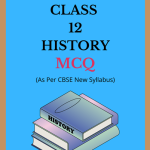NCERT Class 12 History MCQ Chapter 8 Peasants, Zamindars and The State Agrarian Society and the Mughal Empire Solutions to each chapter is provided in the list so that you can easily browse through different chapters NCERT Class 12 History MCQ Chapter 8 Peasants, Zamindars and The State Agrarian Society and the Mughal Empire and select need one. NCERT Class 12 History MCQ Chapter 8 Peasants, Zamindars and The State Agrarian Society and the Mughal Empire Question Answers Download PDF. NCERT History MCQ Class 12 Solutions.
NCERT Class 12 History MCQ Chapter 8 Peasants, Zamindars and The State Agrarian Society and the Mughal Empire
Also, you can read the NCERT book online in these sections Solutions by Expert Teachers as per Central Board of Secondary Education (CBSE) Book guidelines. CBSE Class 12 History MCQ Solutions are part of All Subject Solutions. Here we have given NCERT Class 12 History MCQ Part – I: Themes in Indian History, History MCQ Part – II: Themes in Indian History, History MCQ Part – III: Themes in Indian History. NCERT Class 12 History MCQ Chapter 8 Peasants, Zamindars and The State Agrarian Society and the Mughal Empire Notes, NCERT Class 12 History MCQ Notes for All Chapters, You can practice these here.
Peasants, Zamindars and The State Agrarian Society and the Mughal Empire
Chapter: 8
| THEMES IN INDIAN HISTORY (PART – II) |
| MCQ |
1. Who wrote Ain-i-Akbari?
(a) Akbar.
(b) Abul Fazl.
(c) Todarmal.
(d) None of the above.
Ans: (b) Abul Fazl.
2. What was the central purpose of Ain?
(a) To enable the collection of revenue.
(b) To present a vision of Akbar ‘s empire.
(c) To inform about the peasants and revenue.
(d) All of the above.
Ans: (b) To present a vision of Akbar ‘s empire.
3. What was watan Jagir:
(a) Region coming under local rulers.
(b) Land grant given to the turk aristocracy.
(c) Jagirs given to Ulemas.
(d) None of the above.
Ans: (a) Region coming under local rulers.
4. In 1562 Akbar began the Budget system. Who helped him:
(a) Adham Khan.
(b) Todarnal.
(c) Abdur Rahim Khan-e-Khana.
(d) Aitmad Khan.
Ans: (d) Aitmad Khan.
5. Ahom kings belonged to —-.
(a) Madhya Pradesh.
(b) Bihar.
(c) Orissa.
(d) Assam.
Ans: (d) Assam.
6. There are daftars —- daftars (parts) of Ain.
(a) Three.
(b) Four.
(c) Five.
(d) Six.
Ans: (c) Five.
7. Ottoman empire belonged to — .
(a) China.
(6) Iran.
(c) Turkey.
(d) Iraq.
Ans: (c) Turkey.
8. Identify which of the metal was used more often to make coins during the Mughal Empire?
(a) Gold.
(b) Silver.
(c) Tin.
(d) Copper.
Ans: (b) Silver.
9. During the Mughal Empire, what was Jins-i-Kamil?
(a) Seasonal crop.
(b) Kharif crop.
(c) Rabi crop.
(d) Perfect crop.
Ans: (b) Kharif crop.
10. During the Mughal Empire, how did the Panchayats use the funds available to it?
(a) It was used to entertain revenue officials.
(b) It was used to pay salary to muqaddam and chowkidar.
(c) It was used to meet expenses for the community welfare.
(d) All of these.
Ans: (d) All of these.
11. Identify which of the following statement is correct about Ain-i- Akbari?
(a) Manzil-Abadi: the royal household.
(b) Sipah-Abadi: civil and military administration.
(c) Mulk-Abadi: gives information about the fiscal aspect of the state.
(d) All of these.
Ans: (d) All of these.
12. Identify which of the following was not correct in the context of the Mughal Empire.
(a) States help was available for irrigation.
(b) Jins-i-Kamil was a Rabi Crop.
(c) Many new crops reached India such as maize, potato, etc.
(d) There were two types of peasants-khud- Kashta and Pahi-Kashta.
Ans: (b) Jins-i-Kamil was a Rabi Crop.
13. With which of the following methods, Zamindari consolidation was done in the Mughal period?
(a) Colonisation of new lands.
(b) By transfer of rights.
(c) With the order of the State.
(d) All of these.
Ans: (d) All of these.
14. Which of these was a major reason for the higher status of Zamindars in the Mughal empire?
(a) They had a very high income.
(b) They had extensive personal land.
(c) Most of the time, they belonged to upper castes.
(d) All of these.
Ans: (d) All of these.
15. The Ain is made up of five books, match these books with the given options:
| (i) first book. | 1.Sipah- abadi. |
| (ii) Second book. | 2. Mulk-abadi. |
| (iii) Third book. | 3. Manzil-abadi. |
Correct option is:
(a) (i)-1, (ii)-2, (iii)-3
(b) (i)-2, (ii)-1, (iii)-3
(c) (i)-3, (ii)-1, (iii)-2
(d) (i)-3, (ii)-2, (iii)-1
Ans: (c) (i)-3, (ii)-1, (iii)-2

Hi! my Name is Parimal Roy. I have completed my Bachelor’s degree in Philosophy (B.A.) from Silapathar General College. Currently, I am working as an HR Manager at Dev Library. It is a website that provides study materials for students from Class 3 to 12, including SCERT and NCERT notes. It also offers resources for BA, B.Com, B.Sc, and Computer Science, along with postgraduate notes. Besides study materials, the website has novels, eBooks, health and finance articles, biographies, quotes, and more.




